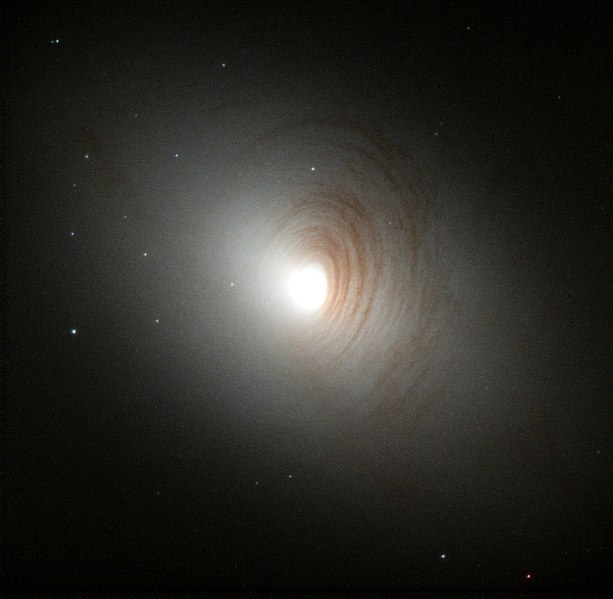Required Lab Preparation:
- Required Reading: Lab 17. It is hard to understand software without first seeing and playing with it, but insofar as possible you should be prepared to use the software.
- Read the Startup Presentation.
- Read IAL 28: Galaxies.
- Read the Post Mortem. Better before than after actually.
- Read a sufficient amount of the articles linked to the following terms etc. so that you can define and/or understand the terms etc. at the level of our class: Andromeda-Milky Way collision, barred spiral galaxy, Coma Cluster, cosmic distance determination, dark halo, elliptical galaxy, galactic bulge, galactic disk, galactic halo, galactic tide, galaxy, galaxy cluster, galaxy formation and evolution, galaxy morphological classification, galaxy merger, Hubble's law, Hubble sequence, Hubble tuning-fork diagram, interacting galaxies, irregular galaxy, lenticular galaxy, Local Group, M87, Milky Way, spiral density wave theory, spiral galaxy, stellar collision, stellar collisions in galaxy collisions, Virgo Cluster.

Caption: A Hubble tuning-fork diagram illustrating the Hubble sequence classification of galaxies.
Credit/Permission: NASA, 1999 (uploaded to Wikipedia by User:Cosmo0, 2007) / Public domain.
Image linked to Wikipedia.
Supplementary Lab Preparation: The items are often alternatives to the required preparation.
- Bennett (2008 edition) p. 635--644 on galaxies and p. 659--665 on galaxy formation and evolution. Most introductory astronomy textbooks have comparable material.
- The Evolution of Galaxy Structure over Cosmic Time, Christopher J. Conselice, Annual Review of Astronomy and Astrophysics, 2014 for those with true grit.
The quiz might be omitted if it's not feasible or convenient. The students may or may not be informed ahead of time of quiz omission depending on the circumstances.

Caption: St. Nestor the Chronicler (c. 1056--c. 1114), St. Vladimir's Cathedral, Kiev, Ukraine.
At his studies.
Credit/Permission: Viktor Vasnetsov (1848--1926), 1919 (uploaded to Wikipedia by User:Butko, 2006) / Public domain.
Image linked to Wikipedia.
The quizzes in total are 40 % of the course grade. However, only the top five quiz marks are counted.
In preparing for a quiz, go over the Required Lab Preparation.
The Supplementary Lab Preparation (see above) could help, but is only suggested if you feel you need more than the required Required Lab Preparation.
There is no end to the studying you can do, but it is only a short quiz.
One to two hours prep should suffice.
There will be 10 or so questions and the time will be 10 or so minutes.
The questions will range from quite easy to challenging.
-
Some of the questions will be thinking questions. You will have to reason your way
to the answers.
The solutions might be posted at Galaxies: Quiz Solutions after the quiz is given. Whether they are or not depends on the circumstances of each individual semester.

Caption: Plato (428/427--348/347 BCE) and Socrates (circa 469--399 BCE) in a Medieval image.
Here the disciple seems to be instructing the master/mentor using the Socratic method.
The basic pose is much like in intro labs.
Credit/Permission: Medieval artist, Middle Ages (probably 1000--1400) (uploaded to Wikipedia by User:Tomisti, 2007) / Public domain.
Image linked to Wikipedia.
- Check as needed:
- This is an inside lab. There is nothing special to put out for the students.
- It is helpful to work your way through the lab especially if you have never done it before---or totally forgotten it.
- See also Diane Smith's instructor notes.
Caption: "Red foxes (Vulpes vulpes)
at the British Wildlife Centre,
Horne,
Surrey,
England."
(Slightly edited.)
Credit/Permission:
© Keven Law,
Photo 2008
Aug17 /
Creative Commons
CC BY-SA 2.0.
Image linked to Wikipedia.
The main task of the lab is to do a
Hubble sequence classification
of a set
of about 70 galaxies in the
Virgo Cluster.
The classification is aided first of all by using
Hubble tuning fork diagram
and second of all a set of example classified galaxies.
The example set is the vital to accurate classification.
The process of classification is more fun than it sounds.
Caption: Cicero Denounces Catiline.
The event happened in 63 BCE.
Togas were in style that year.
Cicero (106--43 BCE) is the most famous
Roman orator.
Catiline (108--62 BCE):
traitor to the Roman Republic
or hero of the Plebs.
Credit/Permission: Cesare Maccari (1840--1919),
1889
(uploaded to Wikipedia
by Donar Reiskoffer (AKA User:Donarreiskoffer),
2006) /
Public domain.
Image linked to Wikipedia.
You learn about the fine points of galaxies,
discuss merits of each classified example as a match to your objects,
argue your views vociferously.
There is a learning curve to climb, but soon you get the hang of it and complete the
classification in a jiffy.
There is a bit of subjectivity
in galaxy classification
by eye.
But it is fast and people doing
galaxy research
want to get a first order answer just by looking at a
galaxy.
If you want a objective, fairly definitive
galaxy classification, then
there are elaborate procedures.
Humans are pretty good
at pattern recognition
and better than machines at least in some contexts---unless my knowledge is out of date.
The figure below is no sweat right.
Caption: Flat-tail horned lizard
with a range that is a small part the Sonoran Desert
not including Las Vegas, Nevada.
You human
have no trouble spotting this critter---a master
of camelflage---who has lost
his/her shadow---like
Peter Pan.
It's very hard for software though
neural networks can learn to
do it.
Credit/Permission:
United States Fish and Wildlife Service,
Jim Rorabaugh
before or circa 2005
(uploaded to Wikipedia
by Eugene van der Pijll (
AKA User:Eugene van der Pijll),
2005) /
Public domain.
Image linked to Wikipedia.
But humans can be at a loss too.
Are they stacked boxes?
Or are they flat?
Caption: Floor tiles
in Archbasilica of St. John Lateran,
Rome, Italy
creating an optical illusion.
Credit/Permission: Tino Warinowski (User:Chino),
2006 /
Public domain.
Image linked to Wikipedia.
Our first order tool is the Hubble tuning fork diagram.
See an example of one below.
Caption: A Hubble tuning fork diagram
illustrating the Hubble sequence
classification of galaxies.
Edwin Hubble (1889--1953)
developed his classification scheme in 1926.
The Hubble sequence
is conventionally illustrated on a
Hubble tuning fork diagram
as shown here.
The Hubble sequence, including
some extensions, includes:
Galaxy formation and evolution
is a complex process.
The merger strips the interacting
galaxies of their
interstellar medium (ISM)
(i.e., interstellar dust and gas)
and disorders the orbital planes
of the stars so that they are no longer
concentrated in a galactic disk,
but have a random orientation.
The overall shape of the merged
spirals
usually form approximate spheroids: i.e.,
ellipsoids.
Classification by the Hubble sequence
is somewhat affected by human
subjectivity.
But it's still highly useful to look at a
galaxy and know with some degree of
certainty what type of galaxy it is.
Credit/Permission: NASA,
1999
(uploaded to Wikipedia
by User:Cosmo0,
2007) /
Public domain.
Image linked to Wikipedia.
The image below gives some insight into
elliptical galaxies.
Caption: A true-color
Hubble Space Telescope (HST)
image of
Abell S740
a rich
galaxy cluster
in the
Abell catalogue of rich
galaxy clusters.
Abell S740
is over 150 Mpc (450 Mly) away in
Centaurus.
Just above the center of the image is the
giant elliptical galaxy ESO 325-G004.
Its mass as 10**11 M_☉---which
actually isn't all that big and I think this is only luminous matter and not counting the
probably larger amount of dark matter.
The HST
resolves thousands of globular clusters
orbiting ESO 325-G004.
In the image, the
globular clusters are not readily
identified, but they are probably some of the light points clustering near
ESO 325-G004. Other points may be foreground or background objects.
The brightest foreground stars
are easily identified as such---they have points.
These stars are heavily overexposed because their apparent brightness is very
high because of their nearness to us.
The heavy overexposure brings out the
diffraction patterns
that their wave fronts create when cut by the
aperture of the
telescope.
The stars are completely
unresolved.
The extended galaxies
are resolved, of course, and their
diffraction patterns
are relatively negligible.
How does one recognize
elliptical galaxies?
This is because almost all their stars
are relatively old stars
and their are no hot young blue stars
(e.g., OB stars).
Star formation
mostly turned billions of years ago in
ellipticals.
And, of course,
ellipticals
don't have spiral arms
which contain blue knots (due to hot young blue stars from recent
star formation)
and dark interstellar dust
(which laces star formation regions).
Image linked to Wikipedia.
The image below gives some insight into
lenticular galaxies (S0 galaxies).
Caption: "NGC 2787 is an example of a
barred lenticular galaxy (i.e., SB0)."
It is about 8 Mpc away in Ursa Major.
NGC 2787 seems to have
dust lanes, but
I guess they are not well defined enough to be considered well-defined
spiral arms.
It's a barred lenticular galaxy, but
I can't make out any bar myself.
Credit/Permission: NASA,
1999
(uploaded to Wikipedia
by User:Severino,
2005) /
Public domain.
Image linked to Wikipedia.
A Question 4a:
There are often multiple large galaxies in the images for classification.
The spreadsheet comments indicate which is the right galaxy to be classified.
This has to be pointed out to the students.
A Question 6b: You will need to explain that the AngSize(') in Table 17.2 is the
larger of the two dimensions in the AngSize(') column in the spreadsheet
for the galaxy and confusingly this AngSize(') is labeled D(')
on the Calculation spreadsheet for the table.
B Question 8: This question has "as your instructor directs you". Well your instructor directs you to measure
the longest dimension of the regions your manual directs you to measure.
A Question 9: You will probably have to spoonfeed the answer to this question to the
students. It's really a bit hard for them to find answers to such questions
of detail in the references.
B Questions 1 and 2 You will probably have to spoonfeed the answers to these questions to the
students. It's really a bit hard for them to find answers to such questions
of detail in the references.
B Question 9c: You will probably have to spoonfeed the answer to this question to the
students. It's really a bit hard for them to find answers to such questions
of detail in the references.
Caption: Film poster for the
TheMummy (1932)
starring Boris Karloff (1887--1969).
Credit/Permission: Employee or employees of
Universal Pictures
attributed to
Karoly Grosz (fl. 1930s),
1932
(uploaded to Wikipedia
by User:Crisco 1492,
2012) /
Public domain.
Image linked to Wikipedia.
Any that are semester-section-specific will have to added as needed.


See The Evolution of Galaxy Structure over Cosmic Time,
Christopher J. Conselice, Annual Review of Astronomy and Astrophysics, 2014
for those with true grit.
But those procedures can err too and have to be corrected by human insight.



Hubble originally thought the
Hubble sequence could be an
evolutionay sequence, but that is NOT the case in any simple sense.
Did I ever mention that I once corresponded with
Gerard de Vaucouleurs (1918--1995):
... the paper on the distance modulus still 'in preparation' probably for ApJ rather than ApJL. GV (1993)
However, one can say that ellipticals probably
are often formed by the merger of
spirals.

Double-click for a high resolution image
The Abell catalogue is
it is an all-sky catalogue with 4,073 rich
galaxy clusters
of nominal cosmological redshift z ≤ 0.2.
The catalog was originally begun by
George Abell (1927--1983).
Globular clusters
compact gravitationally bound star clusters
containing thousands of stars.
In the image, there are other
elliptical galaxies,
spiral galaxies
(recognizable by their
spiral arms),
background galaxies
(that are too small to classify from this image),
and foreground stars.
First, in true color images
(as ours is), ellipticals
are pretty much all yellow.
Credit/Permission:
NASA,
John Blakeslee
(Washington State University),
2007 /
Public domain.


Below are some generic comments for
Lab 17: Galaxies
that may often apply.
